"Three Trees of India", Folio from a Baburnama (Autobiography of Babur)
The Baburnama, one of the most important texts of the Mughal period, provides insight into the literary, intellectual, and cultural world of Babur (1483–1530), founder of the Mughal empire. The Baburnama is especially celebrated for its observations of India's natural world, an aspect of the text most pleasingly captured in the subject matter here. The page depicts three trees: one on the recto (jackfruit) and two on the verso (monkey jack and lote). Interspersed among the images are texts in nasta'liq Persian script describing the trees and their fruits. During the reign of Babur's grandson Akbar (1556–1605), four imperial copies of the Baburnama were created, each illustrated by leading artists of the royal atelier. This folio comes from the earliest of these copies, the 1589 manuscript, which was likely a model for the later versions. It is thought originally to have contained 191 illustrations, many of which were dispersed in 1913, with a substantial portion remaining in the Victoria and Albert Museum, London. The collaboration between two or more artists, as seen here, was typical of early Mughal workshop practice.
Artwork Details
- Title:"Three Trees of India", Folio from a Baburnama (Autobiography of Babur)
- Date:late 16th century
- Geography:Country of Origin India
- Medium:Ink, opaque watercolor, and gold on paper
- Dimensions:H. 9 13/16 in.(25 cm)
W. 5 1/8 in. (13 cm) - Classification:Codices
- Credit Line:Purchase, Louis E. and Theresa S. Seley Purchase Fund for Islamic Art, Anonymous Gift, in honor of Amy Poster, and Friends of Islamic Art Gifts, 2013
- Object Number:2013.576
- Curatorial Department: Islamic Art
More Artwork
Research Resources
The Met provides unparalleled resources for research and welcomes an international community of students and scholars. The Met's Open Access API is where creators and researchers can connect to the The Met collection. Open Access data and public domain images are available for unrestricted commercial and noncommercial use without permission or fee.
To request images under copyright and other restrictions, please use this Image Request form.
Feedback
We continue to research and examine historical and cultural context for objects in The Met collection. If you have comments or questions about this object record, please contact us using the form below. The Museum looks forward to receiving your comments.
